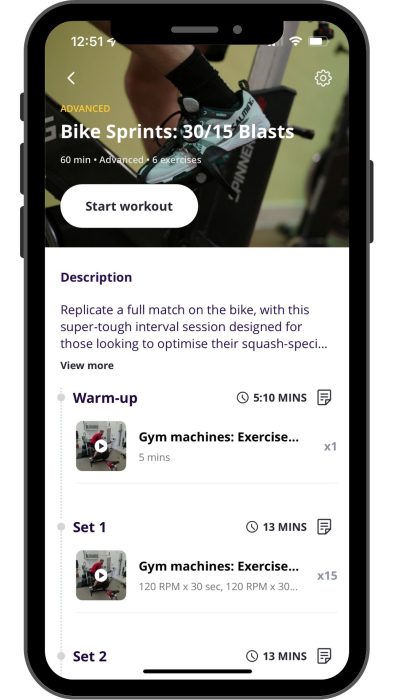Developing a solid base of conditioning is an essential aspect of maximising your on-court performance.
Generally speaking, making your physical training sessions as squash-specific as possible is the best route to optimal fitness – drills such as ghosting, sprints, track, skipping, and circuits are amongst the most commonly used, and are all very useful methods of training.
The issue with these kinds of training methods however, is the continual high load being placed upon the joints. Squash is a very high-intensity sport that inflicts significant stress and strain upon the body, so while we want to replicate these demands in training to a degree, we also need to be very careful not to overload the system and risk triggering injuries.
Whilst finding effective lower-impact squash-specific training methods can be difficult, there is one excellent method that comes highly recommended – Bike Sprints. Convenient, straightforward, and adaptable, bike sprints are a great modality of training for the squash player from amateur to elite. Most gyms have a range of equipment available – from standard exercise bikes, watt bikes, and spin bikes, or you can even set up your own home facility with the use of ‘turbo trainers’ and the like.
The benefits of bike sprints are numerous, but here are some of the most significant:
First and foremost, bike sprints have a high degree of application to squash. The primary muscles used (quads, glutes, hamstrings), and the energy systems stressed (aerobic and anaerobic), are very similar to those used in the sport, and thus there is a high degree of crossover that isn’t always there with other training methods. Squash is a sport composed of repeated high-intensity efforts interspersed with short rest periods, and these parameters can be effectively replicated in your bike sprint sessions.
The lower impact of bike sprint sessions also make them more suitable for a wider range of players. Sessions like ghosting and high-intensity circuits are great methods of training, but place a lot of load on the body – if used too frequently they can sometimes lead to pain and injury, particularly in older players where recovery from physical exertion can take a little longer. Bike sprints are therefore a better choice for amateur players looking to put in a hard training block, as the pounding on the joints from too much on court work is almost completely eliminated.
Another great benefit of bike sprints is the variety and versatility in their use. There are a ton of different ways a bike sprint session can be set up, with adjustments to reps, intensity, recovery, and duration allowing sessions to be tailored to focus more specifically on different elements – from short all-out efforts, to longer more sustained work outputs.
Looking for a good place to start with your bike sprint training?
 One of our SquashSkills favourite bike sprint sessions is the 30/15.
One of our SquashSkills favourite bike sprint sessions is the 30/15.
For this session, you’ll be working sets of 30secs hard efforts, interspersed with 15secs slow pedal recoveries.
Your aim is to work at the highest pace you can sustain for the full 30secs – on a typical exercise bike, keeping a speed of around 105+rpm is a good target, with the resistance level pushed up to around 40% of max (so on a standard 20 level resistance scale, push up to around level 8). This though will be primarily dictated by the particular bike model you’re using, and your own level of conditioning – if in doubt, aim to work at a perceived rate of exertion of around an ‘8/9’ on a 1 to 10 scale on your sprints.
For the 15secs recoveries, you’ll drop the resistance on the bike right back down, and just keep the pedals turning very slowly while you catch your breath. You’ll complete 10 of these 30/15 reps per set – depending on your level of fitness you can build up over time from 1 set to an entire 5 sets, to replicate the demands of a full squash match (taking 2mins rest between each set).
We’ve got a great further selection of bike sprint sessions and programmes over on the SquashSkills Training app that you can set up and work along with directly on your phone. Start your subscription today to access our full library, and check them out.
Sign up to the SquashSkills newsletter
Get world class coaching tips, straight to your inbox!